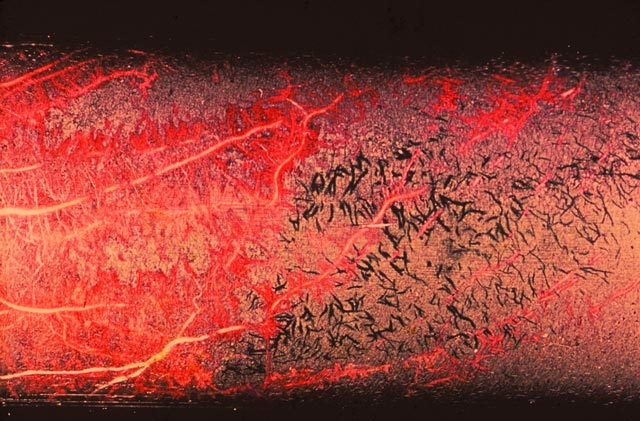Sulfide toxicity
What it does
 Sulfide toxicity cuases roots to be coarse and sparseSulfide toxicity reduces nutrient uptake of plants by reducing root respiration. It has an adverse effect on metabolism, particularly when an excessive amount is taken up by the rice plant.
Sulfide toxicity cuases roots to be coarse and sparseSulfide toxicity reduces nutrient uptake of plants by reducing root respiration. It has an adverse effect on metabolism, particularly when an excessive amount is taken up by the rice plant.
Why and where it occurs
Sulfide toxicity is not very common in rice. It is, however, associated with low-Iron (Fe) soils.
It can occur in well-drained sandy soils, degraded paddy soils, poorly drained organic soils, and acid sulfate soils.
How to identify
Check the field for the following symptoms:
- interveinal chlorosis of emerging leaves
- coarse, sparse, dark brown to black root system
Freshly uprooted rice hills often have poorly developed root systems with many black roots (stains of Fe sulfide) unlike healthy roots, which are covered with a uniform and smooth orange-brown coating of Fe3+ oxides and hydroxides.
Sulfide toxicity can also cause increased occurrence of diseases, such as brown spot (caused by Helminthosporium oryzae), because of unbalanced plant nutrient content caused by H2S toxicity.
Leaf symptoms of sulfide toxicity are similar to those of chlorosis caused by Fe deficiency. Other diagnostic criteria are similar to those of Fe toxicity, but have different visual leaf symptoms.
No critical levels have been established to test Sulfide toxicity.
Why is it important
The symptoms of Sulfide toxicity can occur throughout the growth cycle of the rice. Nonetheless, sulfide toxicity is not very common in rice and thus, tends to be of little economic significance.
How to manage
- Plant tolerant varieties.
Contact your local agriculture office for an up-to-date list of available varieties. - Avoid continuous flooding and use intermittent irrigation in soils that contain large concentrations of Sulfur, have high organic matter status, and are poorly drained.
- Carry out dry tillage after the rice harvest to enhance Fe oxidation during the fallow period, but this will require machinery (tractor).
- Balance the use of fertilizer nutrients (NPK or NPK + lime) to avoid nutrient stress and improve root oxidation power.
- Apply sufficient Potassium (K) fertilizer.
- Avoid using excessive amounts of organic residues (manure, straw) in soils containing large amounts of Fe and organic matter, and in poorly drained soils.
Where possible,
- In temperate climates, coat seeds with oxidants (e.g., Calcium peroxide) to increase the O2 supply and improve seed germination.
- Apply K, Phosphorus, and Magnesium fertilizer; apply Fe (salts, oxides) on low-Fe soils to increase immobilization of H2S as FeS.